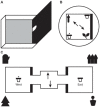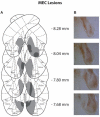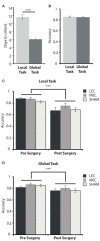Lateral Entorhinal Cortex Lesions Impair Local Spatial Frameworks
- PMID: 28567006
- PMCID: PMC5434111
- DOI: 10.3389/fnsys.2017.00030
Lateral Entorhinal Cortex Lesions Impair Local Spatial Frameworks
Abstract
A prominent theory in the neurobiology of memory processing is that episodic memory is supported by contextually gated spatial representations in the hippocampus formed by combining spatial information from medial entorhinal cortex (MEC) with non-spatial information from lateral entorhinal cortex (LEC). However, there is a growing body of evidence from lesion and single-unit recording studies in rodents suggesting that LEC might have a role in encoding space, particularly the current and previous locations of objects within the local environment. Landmarks, both local and global, have been shown to control the spatial representations hypothesized to underlie cognitive maps. Consequently, it has recently been suggested that information processing within this network might be organized with reference to spatial scale with LEC and MEC providing information about local and global spatial frameworks respectively. In the present study, we trained animals to search for food using either a local or global spatial framework. Animals were re-tested on both tasks after receiving excitotoxic lesions of either the MEC or LEC. LEC lesioned animals were impaired in their ability to learn a local spatial framework task. LEC lesioned animals were also impaired on an object recognition (OR) task involving multiple local features but unimpaired at recognizing a single familiar object. Together, this suggests that LEC is involved in associating features of the local environment. However, neither LEC nor MEC lesions impaired performance on the global spatial framework task.
Keywords: allocentric; hippocampus; medial entorhinal cortex; navigation; object recognition; spatial memory.
Figures






Similar articles
-
Lateral entorhinal cortex lesions impair both egocentric and allocentric object-place associations.Brain Neurosci Adv. 2020 Jul 14;4:2398212820939463. doi: 10.1177/2398212820939463. eCollection 2020 Jan-Dec. Brain Neurosci Adv. 2020. PMID: 32954005 Free PMC article.
-
Navigation using global or local reference frames in rats with medial and lateral entorhinal cortex lesions.Behav Brain Res. 2021 Sep 10;413:113448. doi: 10.1016/j.bbr.2021.113448. Epub 2021 Jul 8. Behav Brain Res. 2021. PMID: 34246711
-
Processing of spatial and non-spatial information in rats with lesions of the medial and lateral entorhinal cortex: Environmental complexity matters.Behav Brain Res. 2017 Mar 1;320:200-209. doi: 10.1016/j.bbr.2016.12.009. Epub 2016 Dec 9. Behav Brain Res. 2017. PMID: 27956211
-
Disentangling the Role of the MEC and LEC in the Processing of Spatial and Non-Spatial Information: Contribution of Lesion Studies.Front Syst Neurosci. 2017 Oct 27;11:81. doi: 10.3389/fnsys.2017.00081. eCollection 2017. Front Syst Neurosci. 2017. PMID: 29163076 Free PMC article. Review.
-
Functional correlates of the lateral and medial entorhinal cortex: objects, path integration and local-global reference frames.Philos Trans R Soc Lond B Biol Sci. 2013 Dec 23;369(1635):20130369. doi: 10.1098/rstb.2013.0369. Print 2014 Feb 5. Philos Trans R Soc Lond B Biol Sci. 2013. PMID: 24366146 Free PMC article. Review.
Cited by
-
Fan Cells in Layer 2 of the Lateral Entorhinal Cortex Are Critical for Episodic-like Memory.Curr Biol. 2020 Jan 6;30(1):169-175.e5. doi: 10.1016/j.cub.2019.11.027. Epub 2019 Dec 12. Curr Biol. 2020. PMID: 31839450 Free PMC article.
-
Lateral entorhinal cortex lesions impair odor-context associative memory in male rats.J Neurosci Res. 2022 Apr;100(4):1030-1046. doi: 10.1002/jnr.25027. Epub 2022 Feb 20. J Neurosci Res. 2022. PMID: 35187710 Free PMC article.
-
A Critical Review of Spatial Abilities in Down and Williams Syndromes: Not All Space Is Created Equal.Front Psychiatry. 2021 May 28;12:669320. doi: 10.3389/fpsyt.2021.669320. eCollection 2021. Front Psychiatry. 2021. PMID: 34122185 Free PMC article. Review.
-
Postnatal development of the entorhinal cortex: A stereological study in macaque monkeys.J Comp Neurol. 2020 Oct;528(14):2308-2332. doi: 10.1002/cne.24897. Epub 2020 Mar 18. J Comp Neurol. 2020. PMID: 32134112 Free PMC article.
-
Bayesian Physics-Based Modeling of Tau Propagation in Alzheimer's Disease.Front Physiol. 2021 Jul 16;12:702975. doi: 10.3389/fphys.2021.702975. eCollection 2021. Front Physiol. 2021. PMID: 34335308 Free PMC article.
References
-
- Benhamou S., Poucet B. (1998). Landmark use by navigating rats (Rattus norvegicus) contrasting geometric and featural information. J. Comp. Psychol. 112, 317–322. 10.1037/0735-7036.112.3.317 - DOI
LinkOut - more resources
Full Text Sources
Other Literature Sources

